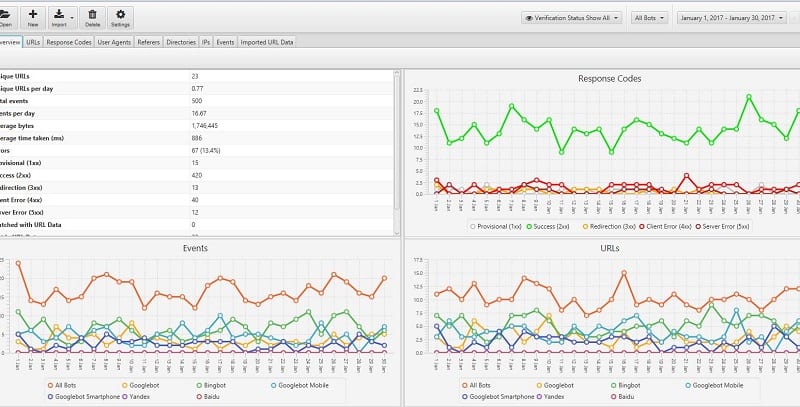Log Files: How You Can Use Them For SEO

What is a Web Server Log and What are Server Log Files?
SEO Opportunities and Improvements That Result From a Log File Analysis
- You can pinpoint where response codes are being generated, and resolve any that are concerning (4xx, 5xx)
- You can identify how frequently GoogleBot and other bots are crawling your website, along with what they’re crawling. With that, you’ll find ways to control the crawl, organize crawl budget, and make the bots work to your advantage
- You can find duplicate crawled pages
- You can notice uncrawled pages and do what is necessary to ensure they’re crawled
- You can clearly see redirect issues and resolve them
- You can identify site performance issues and improve speed
- You can explore your most and least active pages, and potentially find insights into why the bots priorities are the way they are
How to View and Analyze Log Files
The best way to view log files in a way that offers value and insight is through a tool. The standard log files are not the most readable. They include a ton of data, and you’ll need to have some technical savvy to understand them. A tool like one of the following can help you to view the files, understand what’s going on, cross-reference with other crawls, and create action items that will benefit your websites crawlability and ultimately search presence.
Helpful Tools
With most log file tools you: download log files, drag and drop, and the tool will spit out a report. Some more detailed than others. I’m a frequent user of Screaming Frog which has one, and SEMrush is also developing one, which I was excited to see. There are other tools out there, if you’ve used them and think they’re better, I’d love to hear your experience with them. Here’s the basics on SF and a preview for SEMrush:
- Free version, but a license allows you to upload more log events and create additional projects. It’s a separate download from the main screaming frog.
- Drag and drop raw log files
- A report is generated (and it even organizes some key sections for you!)
- Verify search engine bots
- Identify crawled URL’s
- Analyze search bot data for insights
- Can use a variety of tools to visualize, the data, cross reference with a standard crawl, and more for specific date ranges.
SEMrush Log File Analyzer (Coming Soon)
- Drag and drop log files
- SEMrush will generate a report that helps identify
- Errors
- Orphan pages
- Most crawled pages
- Crawl budget and how it can be improved
Is This Part of Your Technical SEO Strategy?
We’d love to hear about your experiences with log file analysis, and any difficulties you may have encountered.
We’re currently performing log file analysis, developing action items, and making improvements for some of our clients. In time, we’ll post updates with the results (improved crawlability, impact on rankings, etc.) If you’ve gone through this process, we’d also love to hear about the results you’ve seen too!
Check out our web hosting capabilities that can help you streamline this process!
Let’s Get
To Know Each Other
Location
Cincinnati, OH (Headquarters)
4907 Eastern Ave Cincinnati, OH 45208
(513) 272-3432
Copyright © . All Rights Reserved.

